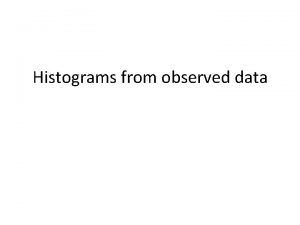Histograms Histograms Example A Histograms are a useful








- Slides: 8

Histograms

Histograms – Example A Histograms are a useful way to illustrate the frequency distribution of continuous data. For example, the data in the table below show the lung volume of a group of students. Lung volume (litres) Frequency 2. 5– 2. 9 2 3. 0– 3. 4 5 3. 5– 3. 9 8 4. 0– 4. 4 11 4. 5– 4. 9 9 5. 0– 5. 4 4 5. 5– 5. 9 1 What are the class widths?

Histograms – Example A Since the classes are of equal width, a standard histogram can be Remember to give drawn, using the frequencies for height. your histogram a title. Histogram showing lung volume of Year 11 students Frequency The vertical 12 axis represents the frequency. 10 8 6 There are no gaps between the bars because the data are continuous. 4 2 0 0 -0 2. 5 - 2. 9 3. 0 - 3. 4 3. 5 - 3. 9 4. 0 - 4. 4 4. 5 - 4. 9 5. 0 - 5. 4 5. 5 - 5. 9 6. 0 Lung volume (litres) The horizontal axis represents the lung volume (litres) and contains the classes of the frequency distribution.

Histograms – Example A Lung volume of Year 11 students 12 Frequency 10 The shape of the line is the frequency distribution. 8 6 4 2 0 0 -0 2. 5 - 2. 9 3. 0 - 3. 4 3. 5 - 3. 9 4. 0 - 4. 4 4. 5 - 4. 9 5. 0 - 5. 4 5. 5 - 5. 9 6. 0 Lung volume (litres) A frequency polygon is obtained by joining the mid-points of the top of the histogram bars.

Histograms – Example B If the classes are not of equal width, we cannot use the frequency as the vertical axis. This is because the frequency needs to be shown by the area of the bar, not just the height of the bar. What are the class widths in this example? Lung volume (Litres) Frequency 2. 0– 2. 9 2 3. 0– 3. 2 6 3. 3– 3. 5 8 3. 6– 4. 0 10 4. 1– 5. 0 9 5. 1– 5. 5 4 5. 6– 5. 7 1

Histograms – Example B Instead of using frequency on the vertical axis, frequency density is used. Frequency density is calculated by the following formula: Frequency density = frequency/width Lung volume (litres) Frequency Class width Frequency density 2. 0– 2. 9 2 1. 0 2. 0 3. 0– 3. 2 6 0. 3 20. 0 3. 3– 3. 5 8 0. 3 26. 6 3. 6– 4. 0 10 0. 5 20. 0 4. 1– 5. 0 9 1. 0 9. 0 5. 1– 5. 5 4 0. 5 8. 0 5. 6– 5. 7 1 0. 2 5. 0

Histograms – Example B This time, frequency density is plotted against lung volume. The area of the bar represents the frequency. 2. 0 3. 3 3. 6 4. 0 5. 5 5. 7

Other types of graph Histograms are one way of illustrating data. Others include: -bar charts -line graphs -pie charts -scatter diagrams. www. bbc. co. uk/schools/gcsebitesize/maths /statistics/representingdata 2 rev 5. shtml















